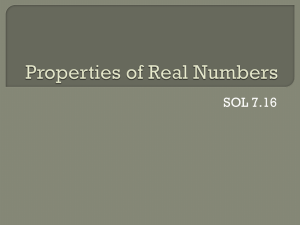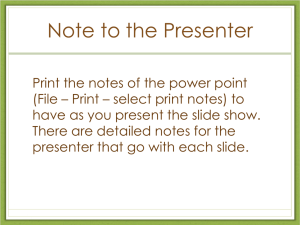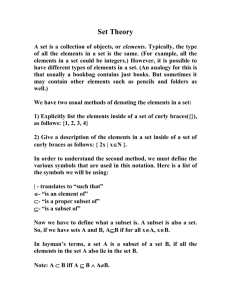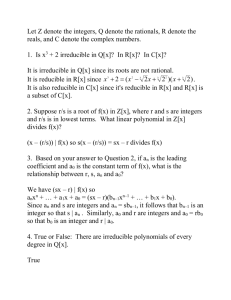0312Chapter01 - mathdoctor1999.com
advertisement
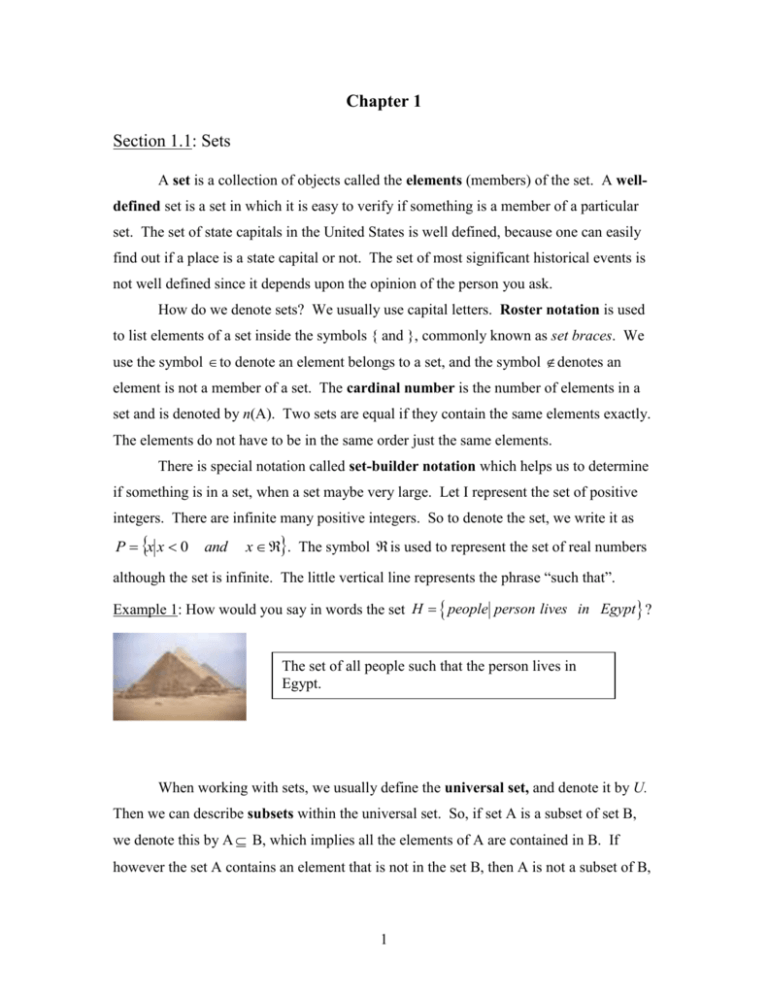
Chapter 1
Section 1.1: Sets
A set is a collection of objects called the elements (members) of the set. A welldefined set is a set in which it is easy to verify if something is a member of a particular
set. The set of state capitals in the United States is well defined, because one can easily
find out if a place is a state capital or not. The set of most significant historical events is
not well defined since it depends upon the opinion of the person you ask.
How do we denote sets? We usually use capital letters. Roster notation is used
to list elements of a set inside the symbols { and }, commonly known as set braces. We
use the symbol to denote an element belongs to a set, and the symbol denotes an
element is not a member of a set. The cardinal number is the number of elements in a
set and is denoted by n(A). Two sets are equal if they contain the same elements exactly.
The elements do not have to be in the same order just the same elements.
There is special notation called set-builder notation which helps us to determine
if something is in a set, when a set maybe very large. Let I represent the set of positive
integers. There are infinite many positive integers. So to denote the set, we write it as
P x x 0
and
x . The symbol is used to represent the set of real numbers
although the set is infinite. The little vertical line represents the phrase “such that”.
Example 1: How would you say in words the set H people person lives in Egypt ?
The set of all people such that the person lives in
Egypt.
When working with sets, we usually define the universal set, and denote it by U.
Then we can describe subsets within the universal set. So, if set A is a subset of set B,
we denote this by A B, which implies all the elements of A are contained in B. If
however the set A contains an element that is not in the set B, then A is not a subset of B,
1
denoted A B. One other special set is the empty set. The empty set is denoted as .
The empty set is just that, empty. It has no elements.
Example 2: Let U = {planets they belong to the Milky Way Galaxy} be the universal set.
Determine if the following sets are subsets:
A = {Mars, Earth, Saturn}, B = {the Sun}, C = { } .
Solution: Since Mars, Earth, and Saturn, are all planets
and are contained in the Milky Way Galaxy, we have,
A U. Since the Sun is not a planet, we have that even
though it is contained inside the Milky Way Galaxy, it still
We are here?
is not a subset or B U. Since C is the empty set, it does
not contain anything that is not in U, hence C U. In general, the empty set is always a
subset of any set!
We use Venn diagrams to visually show the relationships between sets. A
rectangle represents the universal set U ,with closed figures inside representing various
sets. Here we can see that every element
U
of A is inside B, because A is contained
wholly inside of B, hence A B. Both
B
A and B are sets contained inside the
A
AB
universal set U.
Now if two subsets, A and B are
equal, then every element of one subset is also an element of the other subset. Hence, in
this case A = B, so A is called an improper subset of B, and B is an improper subset of
A. Therefore, every set is an improper subset of itself. If A is a subset of B, but B
contains an element not in A, then A is a proper subset of B. We use the symbol to
denote a proper subset. Hence, although both and symbolize subsets, the symbol
stresses the fact that the subset is proper.
If an element of one set is also contained in another set, that element(s) are called
the intersection of the two sets. We denote the intersection of two sets as . Hence, if
two sets A and B have a common element(s), denoted by A B = {x x A and x B}.
2
Example 3: Ms. Smith divided her class into two groups. A = {Lisa, Bob, Evan, Austin,
Ann, Jake, Peter, Mike} B = {Sydney, Evan, Pam, Mike, Kevin,
Sue}. Who will be in both groups?
Solution: We are asked to find the intersection of the two sets.
So, who is in both set A and B? A B = {Evan, Mike}.
Ms.Smith
Sometimes two sets, A and B, have no common elements. When this happens we
say A B = . These sets are called mutually exclusive or disjoint.
U
B
A
A B=
We use “or” when we talk about the union of sets. The union of two sets A and B
will form a new set. We denote the union of two sets as A B ={x x A and x B}.
The “or ” in the union of sets means all elements in either set or in both sets, that is, their
intersection.
UU
A
B
AB
Example 4: For the following sets, find A B and A B .
A = { 1,2,3,4,6,8,9} and B = {1,2,6,20,22,10,11,4}
A B= {1,2,3,4,6,8,9,20,22,10,11} and A B = {1,2,6,4}
When we are working with three or more sets, we use parenthesis just like when
we are working with numbers.
3
Example 5: For the following sets A = {2, 4, 6, 8}, B = {1, 2, 3, 4} and C = {1, 5, 10, 15}
list the elements of A B C .
Solution: The elements of A B = {1, 2, 3, 4, 6, 8}. Now we need to find the
intersection of this set and C, which will be {1}.
Section 1.2: The Real Numbers
The set of numbers that we use in algebra are the real numbers. There are some
subsets of the real numbers that we should get familiar with. The set of counting
numbers/natural numbers is the set N = {1, 2, 3, 4,…}. The set of whole numbers is
W = {0, 1, 2, 3,…}. The set of integers is the set of whole numbers along with their
negatives J = {…, -2, -1, 0, 1, 2, …}. The rational numbers are numbers that are
expressed as ratios or as quotients of integers. We usually denote the letter Q to name the
set of rational numbers,
a
Q a and b are integers with b 0 .
b
Another way to represent rational numbers is by their decimal form. Recall, that the
numbers whose decimals terminate or repeat are the rational numbers.
We need to review how we graph solutions on the number line. Recall, that a
number line is a line that has an arrow on both ends, indicating that it runs infinitely in
both directions. The numbers on the number line are called the coordinates of the
points. The distance between any two consecutive integers is called a unit. The point
with coordinate 0 is called the origin. When we put on a number line a solution to a
problem, we call this graphing the solution set on the number line.
5
4
3
2
1
0
1
2
3
4
5
Recall that to graph a solution on the number line, if a coordinate is included in the
solution, you put a darkened circle at that coordinate. If a coordinate is not included in
the solution set, you put an open, or non-filled in circle at the coordinate.
4
Irrational numbers are numbers that when put into decimal form, the decimals
neither repeat nor terminate. One well know irrational number is the number
number is actually
.
This
22
, and when this is put into decimal form it does not terminate or
7
repeat.
Section 1.3: Operations on the Set of Real Numbers
One familiar operation on the set of real numbers is the operation of absolute
value. The absolute value is the distance from the origin a number is. Because distance
is not negative, the absolute value of a number is positive. For example, 4 4 4
which means that the numbers – 4 and 4 lie the same distance, 4 units, from the origin.
Two numbers like these that lie on opposite sides of zero and have the same absolute
value are called opposites of each other. Every number has a unique opposite.
Opposite of an Opposite
For any number a, - ( - a) = a.
RECALL: That if you have an even number of negatives multiplied together the answer
is positive. If you have an odd number of negative multiplied together the answer is
negative.
Example 1: Evaluate the opposites of the following numbers.
a.)
– (- 25)
b.)
- ( - (- 9 ) )
Solution: To find the opposite of the numbers we put another negative in front of them.
a.) – ( - ( - 25 ) ) = - 25.
b.) – ( - ( - ( - 9 ) ) ) = 9
The definition of absolute value can be rewritten in terms of opposites. The
definition for absolute value is:
a, a 0
.
a
a, a 0
5
The hardest part of adding numbers, is the possibility of confusing the sign of the
answer. If two numbers have the same sign and you add them, then the answer will have
the same sign as the numbers you are adding. So you think of it as adding the numbers
absolute values, then giving the answer the same sign as the numbers you added.
Example 2: Add –2 and –5 together. Add 2 and 5.
Solution: We think of adding the absolute values of –2 and –5, since both numbers are
negative, their sum will be negative. Hence, (-2) + (-5) = -7.
To add 2 and 5, just add together and the sign of the answer will be positive. Hence their
sum is 2 + 5 = 7.
Because when you add a number a, and its opposite, -a, you get zero, we call
them the additive inverse of each other. Hence, we have the following property,
Additive Inverse Property
For any real number a, there is a unique number –a, such that,
a + (-a) = -a + a = 0
When we add two numbers with different signs, the sign of the answer will have
the same sign as the number with the larger absolute value.
Sum of two numbers with Unlike Signs
To find the sum of two numbers with different signs, subtract their
absolute values.
1.) The sum is positive if the number with the larger absolute value
is positive.
2.) The sum is negative if the number with the larger absolute value
is negative.
Example 3: Add the following pairs of numbers: -10 and 5, 25 and –3, 61 and –60.
Solution:
6
a.) To add –10 and 5, subtract their absolute values. Since –10 has the larger
absolute value, the answer will be negative. So we have 10 – 5 = 5, so we put a
negative on it and the answer is –5.
b.) To add 25 and –3, we subtract their absolute values. Since 25 has the larger
absolute value, the answer will be positive. So we have 25 – 3 = 22.
c.) To add 60 and –61 we have 60 – 61 = -1.
To subtract numbers, just think of it as adding numbers with different signs. In
fact we can think of it as follows:
Subtraction of Real Numbers
For any two numbers a and b,
a – b = a + (-b)
Example 4: Find the difference of the following numbers:
a.)
-10 – 5
b.)
19 – (-2)
c.)
.5 - .6
Solution:
a.) –10 + (-5) = -15
b.) 19 + (-(-2)) = 19 + 2 = 21
c.) .5 - .6 = -.1
To multiply numbers, the resulting number is called the product of the numbers.
The numbers that are multiplied to find the product are called factors. Multiplication is
just shorthand for repeated addition. In other words, 2 5 is just 2 added to itself 5 times.
So we have 2 5 = 2 + 2 + 2 + 2 + 2 = 10 & (-2) 5 = (-2) + (-2) + (-2) + (-2) + (-2) =-10.
Product of Signed Numbers
To find the product of signed numbers, if the number of negative signs are
even, then the product will be positive. If the number of negative signs is
odd, then the product will be negative.
Example 5: Multiply (-2)(-3)(-5) and (-2)(-4)(-1)(-3).
Solution:
7
a.) For (-2)(-3)(-5), since there are an odd number of negative numbers, the answer
will be negative. Hence the product is – 30.
b.) For (-2)(-4)(-1)(-3), since there is an even number of negative signs the answer
will be positive. Hence the product is 24.
Just as every non-zero real number has an additive inverse, it also has what is
called a multiplicative inverse or reciprocal. The product of a number and its
reciprocal is 1.
Multiplicative Inverse Property
For any nonzero real number a, there is a unique number
a
1 1
a 1
a a
Example 6: Find the multiplicative inverse of
Solution: We know that the product of
know that the multiplicative inverse is
1
such that,
a
3
.
5
3
and its multiplicative inverse is 1. We also
5
1
. When we put 1 over anything that flips the
3
5
number around. Hence the multiplicative inverse is
5
3 5
. To check, 1.
3
5 3
Recall, that to divide numbers, we rewrite the expression as multiplication with
the divisor written as its multiplicative inverse.
Division of Real Numbers
For any numbers a and b , with b 0 we have,
1
a b a
b
If a b c , c a number, then a is called the dividend, b is called the divisor
and c is called the quotient.
8
When dividing signed numbers, if you have
.
; ; ;
Hence, if the sign of the numerator and denominator are different the answer
is negative. If the sign of the numerator and denominator are the same, the answer is
positive.
Caution: Remember that we NEVER divide by zero. To divide by zero makes
the fraction undefined. For example,
7
is called undefined!
0
HOWEVER if the zero is in the numerator the fraction is equal to zero. That is,
0
0.
7
PLEASE understand the difference in the placement of the zero!
Section 1.4: Evaluating Expressions
An arithmetic expression is the writing of numbers in meaningful combinations
using addition, subtraction, multiplication, and division. We use parenthesis to group
certain numbers and symbols together. If numbers appear in absolute value symbols,
then you evaluate them first, then take the absolute value.
Exponential expressions are expressions raised to powers. For example, 54 is 5
multiplied to itself 4 times.
Exponential Expression
For any natural number n and real number a,
a n a a a a... n times.
We call a the base, n the exponent, and
a n the exponential expression.
NOTE: If n is even and the base is a negative number, the answer will be positive. In
other words, a negative number raised to an even power gives a positive answer.
9
Example 1: Evaluate
Solution:
5
5
4
4
.
5 5 5 5 625.
CAUTION: In general the following is true:
a
For example, 7
2
power
a power .
49 7 2 49 .
We also need to review square roots. Recall the following:
Square Roots
a 2 b , then a is called a square root of b. If a 0 , then a is called
the principal square root of b and we write b a .
If
RECALL that the square root of a negative number is an imaginary number. We will
see more of this later.
Remember that to simplify an arithmetic expression, we have rules called the
order of operations.
Order of Operations
Evaluate inside any grouping symbols first. Where grouping symbols are
missing, use the following order.
1.) Evaluate each exponential expression (in order from left to right).
2.) Perform multiplication and division (in order from left to right).
3.) Perform addition and subtraction (in order from left to right).
Example 2: Simplify the following expressions:
a.)
- 5 (6 + [(5 - 7) – 4 ])
b.)
10
1 2 8
3
Solution:
a.) - 5 (6 + [(5 - 7) – 4 ]) = -5 (6 + [ -2] – 4) = -5 ( 6 – 2 – 4 ) = -5(4 – 4 ) = -5(0) = 0
b.) 1 2 8 1 6 1 216 216.
3
3
When we combine numbers and variables with arithmetic operations we get
algebraic expressions. For example, 2x + 3y is an algebraic expression, or just an
expression. When we substitute values in for the variables, we call this evaluating
the algebraic expression.
Example 3: Evaluate the following expression for a = - 2 and b = 3.
a.)
ba
a2
b.)
b2 a
ba
a 2 b2
c.)
Solution:
b a 3 2 3 2 5
a.)
2
a2
4
4
2
c.)
b 2 a 3 2 9 2 11
2
b.)
3 2
ba
5
5
1 .
2
2
2
2
a b
2 3 4 9 5
Sometimes when we are working with variables, we want to use the same
variable, but we use subscripts to show that the variables will have different values. For
example, we might use
y1 which is read as “y sub one”.
To evaluate expressions with
subscripts is the same as before. Just replace the variable with the subscript with the
value you are given for that variable with the subscript.
Example 4: Evaluate the expression for x1 1, x2 3, y1 4, y2 5;
Solution:
y2 y1 5 4 1
.
x2 x1 3 1 2
11
y2 y1
.
x2 x1
Section 1.5: Properties of the Real Numbers
There are several properties of the real numbers we need to review. These
properties are important when working with complex expressions.
Commutative Property Both Addition and Multiplication
For any real numbers a and b we have the following:
a+b=b+a
ab = ba
The commutative property says that the order of addition/multiplication does not matter.
That is, 7 + 3 = 3 + 7 and (3)(7) = (7)(3).
Associative Property Both Addition and Multiplication
For any real numbers a, b, and c, we have the following:
a b c a b c
ab c a bc
Example 1: Use the commutative and associative properties to evaluate the expression.
8 12 9 15 6 22 3 .
Solution: We can rewrite this expression using the commutative and associative
properties so that we can combine the positive and negative numbers together.
8 12 9 15 6 22 3 8 12 9 15 6 22 3
12 6 3 8 9 15 22 21 54 33
Distributive Property
For any real numbers a, b, and c,
a b c ab ac
Example 2: Use the distributive property for –2( 3x + 9y).
Solution: -2( 3x + 9y) = -2(3x) + (-2)(9y) = -6x – 18y.
12
There are two special properties, the additive identity property and the
multiplicative identity property. These properties are as follows:
Additive Identity Property
For any real number a,
a+0=0+a=a
Multiplicative Identity Property
For any real number a,
a 1 = 1 a = a
13





